Gus's Musings
September 13, 2017
On a cool and windy September day, a total of 60 plus people gathered to have a close look at some of the helpful technological tools that they could use on their properties. The day started in the woolshed talking about how to tell the difference between a really valuable tool and just something new and shiny that is cool. A strong focus of the day was about developing a plan to make the most of new technologies and examining how they would fit into each producer’s management system. The answer to this question would be different for each individual and that there is no one right (or wrong) way to manage a pastoral business. In fact, it is much better for the whole community to embrace a diversity of methods, in line with a diversity of products they produce. The focus should be more on the outcome or implications of different methods, here the talk was around increasing profitability and/or production also improving the resource base (environment, people and money).
As chairman of the regional SAMRC committee Gus Whyte encouraged everyone to provide feedback on RD&A needs for the region and how that can be considered by research groups, extension providers and consultants.
After a wonderful smoko provided by the Pooncarie Outreach Centre School, we divided up into 5 smaller groups so that we could hear about each product/service and have time to ask questions to see if they would suit our respective needs.
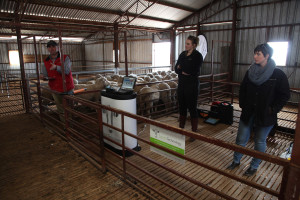
(If you would like to know more on the issues, click on company names to bring up their website)
Group 1
Drones
Uses, mustering, water, fence monitoring
JSL Drones
Group 2
Electronic ID
Hardware
Software
Data use, stock selection
Gallagher, Sapien, Sheepmatters, Leader Products
Group 3
Electric fences
Multi species fences
Westonfence Gallagher
Group 4
Telemetry
Satellite based monitoring
Farmbot
Group 5
Planning & Record keeping
Mapping
Livestock records, chemical diary
AgriWebb
After every group had been around to the 5 work stations (40min), then we all came together for Ash Sweeting to put some perspective on the uses of technology in a rangeland environment. Ash spoke of the importance of gathering relevant data, turning it into useful information, the payback however wouldn’t come until after you had made changes and acted on that information. Attendees were also asked as to what their R&D requirements might be and some of the benefits of working as groups to resolve issues.
Below are some key points out of the day:
- There is a range of tech for a range of purposes. Identify the areas of most potential gain in your business and look for tools to best address that.
- Getting involved in tech isn’t necessarily expensive or overly difficult and potential returns can be huge. Just an investment of $2,000, could save/make you 10 times that.
- There is the risk of being overwhelmed by available tech and the data produced from it, if tools are purchased without a clear goal in mind.
- When it comes to technology (and other issues) “it’s much easier to keep up, than catch up”. Lack of skills shouldn’t be a barrier with lots of training programs (and grants through Local Land Services) available.
- Forming groups to deal with issues is a very effective means of resolving problems, whether it be eliminating pests or R&D on sheep genetics for example.
The day finished up with a few refreshments and lots of talk about the opportunities that the day offered.
Thanks to Western Local Land Services, SAMRC and the Pooncarie Field Day Group for their generous support of the field day. Also a big thanks to all the companies that made a huge effort to come out here and show their goods and services off so well.
If anyone would like to run a field day similar, or have another idea, they should contact Jasmine Wells (LLSWestern) 0417 488 496
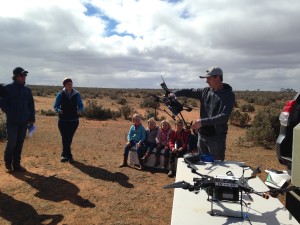
This day was made possible by the generous support of:
Western Local Land Services
Pooncarie Field Day Group
Southern Australia Meat Research Council (SAMRC)
November 19, 2016
Western Resilient Landscapes (Soils For Life) Project
Wyndham Field Day
Featuring Nigel Kerin
“Retail Agriculture”
Friday 4th November 2016
The field day began with an introduction by Western LLS and a brief history on how the project came about and the importance of the support that mentoring provides while going through change. This just gave a timely reminder about how we can always be striving to improve our farming methods and the role a network of likeminded people play in helping that happen. This was followed by Kirsty Yeates from Soils for Life giving us a short talk on how Soils for Life and the Rotary Club of Sydney decided to partner with Western LLS on this project, the importance of healthy soil for our community.
The day was about gaining an understanding of what Kelly and Gus are looking to achieve on Wyndham, however the best part of the day was hearing the “focus speaker”, Nigel Kerin (“Kerin Poll” Yeoval NSW). Nigel reminded us all about the importance of profit in Ag, through his talk titled “Retail Agriculture”.
To sum up the day I would like to just present the points that myself (and others that kindly contributed) thought stood out and feel we need to remember them.
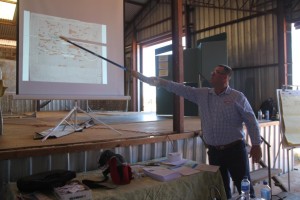
Nigel showing the “power” of grazing charts
So here are the key points/quotes/gems: (They are in no particular order)
#1. Don’t be a victim, land managers need to take responsibility for the landscape and take ownership of creating the landscape they want to see.
#2. Don’t accept that the way things are is the way things have always been or have to always be.
#3. Profits can be made in time, landscape and $. Regardless of the profits made in landscape and time, you still need to make money.
#4. Succession plan, where everyone involved means they can achieve their potential
#5. If the landscape is in stable condition that doesn’t always mean it is healthy
#6. Focus on what builds wealth: people, self improvement, soils, plants, livestock
#7. Build resources so it’s valued by the wider community – Profit
#8. Better connection with the land, learn from the Aboriginal people
#9. Training/courses, consistently improve: Grazing for profit, Low stress stock handling, KLR marketing etc.
#10. “Retail Agriculture” – profiting from your most important asset, your GRASS
#11. Dollars per hectare much more important than $$ per unit.
#12. W.O.T.B. (Working On The Business) monthly meetings, what went well and how can we do better
#13. Do physical grass budgets and no hand feeding
#14. Increase plant production & diversity, which in time will increase carrying capacity.
#15. Incorporate trading into your livestock business to increase profit and as part of your drought policy.
#16. “Sell your grass to the highest bidder” – Make sure you are carrying the most profitable class of livestock.
#17. Drought is a lack of profit not a lack of rain.
#18. We are either ‘regenerating’ or ‘degenerating’ – there is no steady state.
#19. If stock are ‘too dear’ to buy, they are ‘too dear’ to own.
#20. If you are in ‘overload’ you will never get to innovation mode.
#21. If you are not matching stocking rate to carrying capacity, you are in ‘existence mode’ of thinking rather than an ‘abundance mode’ of thinking.
#22. Continue to update your drought response ‘hit list’
#23. Match the class of stock to the grade of feed (rocket fuel, diesel, unleaded or cardboard.)
#24. Find out what you do well and then do more of it – fertility, weight gain, wool cut etc.
#25. Be a “Herd Quitter” be a thinker, thinkers don’t follow, they innovate, break new ground and are adaptable to change.
#26. Protect your grass and treat it like a bank, it is a major asset
#27. Borrow money for things that create cash, eg. Livestock. Fixed assets don’t create income
#28. There is a lack of knowledge in the agricultural industry, and we need to attract younger people – the only thing that will achieve this is profit/money.
#29. 90% of agriculture believes the more animals the more profit
#30. “You don’t get your shearing contractor to re-wire the woolshed, so why use the accountant to do a succession plan?”
#31. “If you use a grazing chart, you can be selling before the neighbours even realise it is dry”
#32. “Change of your grazing system is a bit like giving up smoking” – Need lots of support, this is where a mentor/s comes in
#33. “The cancer of change is retrospective thinking” (don’t want to do that to young people)
#34. “If you don’t bring people that challenge you into your business you’ll be stuck where you are.”
#35. You can make fairly reasonable assessments of weight gain/loss by the shape and consistency of the stocks dung.
#36. Importance of working together as a team. Involve everyone in the business, partners of staff included. “Together we are smarter than any one person”
#37. Knowledge costs nothing, but you need to listen to find it.
#38. “Always have more grass than stock, and never let water leave your place.”
#39. “Everyone’s too busy being busy to make money.”
#40. “It isn’t what people do or the way they do it, it is why they are doing it that is important”.
#41. “Identify the 5 people you spend the most time with (counting family as one), they will be either taking you up, or taking you down”

Audience in the paddock
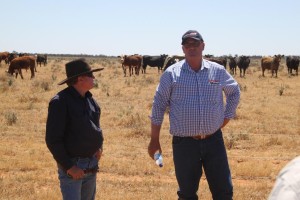
Gus and Nigel
Books and Resources (discussed on the day):

October 23, 2016
“It is too expensive to get into farming” I hear many people say. This is very true if you see the only way into farming is to own the farmland and then work that farm for effectively a wage, a job. That means that if the commodity price increases or decreases it is just a wage rise or cut, likewise if the season is good or bad. The reason I call it a wage even when most farms are owned by small family businesses ( making the workers self employed), is that the real estate value of grazing land (not sure if it is the same in cropping) is based on about a 2% ROI for average farmers. Using this thinking that is why banks require most farmers to have >70% equity, otherwise you won’t be able to cover interest. If you have to borrow a lot of the money farming is a very expensive way of buying a job!
“Farming is a good investment” This may seem almost the opposite to above, however as the greatest “return” to the average farmer comes from capital gains (this is only superannuation to career farmers) then this is why it is seen as a good investment, same reason people want to own their own house rather than rent. According to my understanding of the way Macquarie Bank sell their rural property invest portfolio, they split it up as 2% net lease and 7% capital gain, adding up to a total of 9% ROI. A very handy return indeed, especially in the low interest market that currently exists. I reckon most buy farms looking at the long term investment, resigned to the fact that you can only get small returns from farming.
“How do you enter into farming as a career”? Well the idea here is to take small steps in to farming so that when/if you enter into the farm real estate market you can deliver a much higher return than the average. i.e. make farm land more valuable to you as you have the skills to get a better return. With farming being like most other skills, what you learn from a higher education course starts your learning only and it is very important you spend your whole life learning, adjusting, changing as required to keep your skills sharp. This comes easily if you follow your passion and surround yourself with passionate energized people, then farm without compromising your values.
“Where is the opportunity here?” The opportunity exists for people that have the flexibility and willingness to take on new ideas, change to improve, not because you are forced and importantly view farm with an open mind. Now this mightn’t sound too difficult, reality is that the reason that only the top 20% of livestock farmers make good returns on their land (>8%) is that it takes a fair bit of guts to be as Kit Pharo calls them “A Herd Quitter”. A herd quitter is the 1 sheep/cow that is always looking for their own path, very annoying if you are working the mob, they are the only ones thinking, those following the herd are doing, without much thinking.
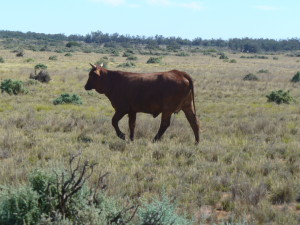
So if you can arm yourself with a support network and be always seeking new options/ways of managing your land and stock, there is no doubt a bright future exists for you in the farming sector (or any other sector for that matter!).
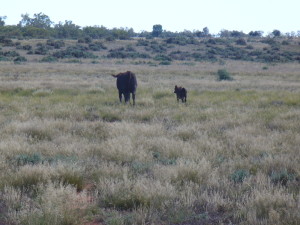
May 29, 2016
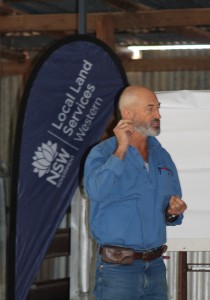
Dick Richardson
24th May 2016
We drove about 70km out of Bourke towards Weilmoringle and found ourselves in the woolshed at Gurrawarra, the wonderful property of Glenn and Julie Humbert. The day began at about 10am with a short introduction from Russel Grant (LLS Western) on the background of this project and how important the LLS saw it for our area. As part of this Russell explained that the Sydney Rotary Club had been helping landholders during droughts by funding “Hay Drives” to drought affected areas, however, via Soils For Life wanted instead, to invest in a more long term approach to helping farmers manage through drought. This approach would be through assisting farmers teach each other about developing healthy soils, the basis for resilient and regenerative landscapes.
Martin Royds then spoke on behalf of Soils for Life as they are partners in the project, thanks to the valuable and generous support of the Sydney Rotary club. Martin spoke about the history of Soils for Life and how that came about through the sustainable production of nutrient rich food as a way of ensuring healthy happy communities around the world that didn’t need to invade others due to hunger, so reduce war. Martin made it very clear that healthy soils lead to healthy food, healthy people, healthy communities etc., it all starts from the soil. Martin also made the point he has been working on identifying the difference in nutrient richness of foods grown on healthy soil and how if we valued food on its available nutrients, rather than weight that everyone was a winner – the consumer gets to choose healthy food, the community gets healthy, the government saves on its health budget, the farmer gets paid for producing a quality product and all the while building a stronger and more diverse natural environment.
In their introductions, both Russell Grant (Western Local Land Services) and Martin Royds (Soils For Life) mentioned that the pastoral industry seems, in general terms, slow to accept outsider’s advice. With new technology tools like drones etc, participants can look down on their country, not over it to appreciate landscape function. This enhances our opportunities to manage regenerative grasslands for reproductive animals in a healthy environment which breeds healthy people, food and fibre and increases nett returns to all involved.
We then heard from Glenn on their journey to the purchase of Gurrawarra in 2010 and what has happened up until now. What I could see/hear was lots of training and experiences, followed by some infrastructure that went in obviously after much thought and planning. Glenn and Julie though are always looking for, “what is the next step”, didn’t ever get the feel that “well we’ve arrived that is OK lets just keep doing this”. They reckon that there positive achievements are expressed ultimately in the happiness of the people and there has been no single secret to that, they have worked on many fronts. They wanted to stop being a miners of the land and to be a part of the movement to improve the land, regenerative. The closing comment was if they did their entire infrastructure again they would put in TGP boundary fencing first. Native wildlife is the greatest threat to the control of TGP and continues to be the most common problem facing all rangeland communities. Numerous control plans are being considered including fencing configurations of various sizes, costs and capabilities.
After a short break Dick Richardson started his talk and with his amusing and engaging method of mixing his landscape interpretations with science, humour and many tales.
He started his talk explaining some of the management regimes that were and had been in place in his native South Africa and these “patterns” as he later called them led to scrub encroachment, more burning and generally simplified grasslands and ecosystems. Most in the room recognised that that was the case with the “pattern” we used in Australia as well and so Dick described this by saying “Nature works in patterns and the whole is a result of the pattern”. We all agreed that biodiversity is important, so if that is the case then we need a diversity of patterns, or even become patternless. ∆=∆ (Change equals change). Then Dick gave us a lesson in Thermodynamics, saying it takes a given amount of energy to create something and from that moment they start to decay, so it takes more energy just to retain that form. Then a large amount of energy (or an event as Dick called it) comes along and the form is changed. The creation/landscape is a result of how the energy is put together, the pattern, change the pattern and you change your landscape. A simple system/pattern, always results in a simple ecosystem, which we all decided we don’t want.
Dick told of an example of two properties he knew in the same area one had a set rotation with 150 paddocks and 2000 cows on one day moves good things had happened but the soil was dead and lifeless at depth. The other had a confused system with no set pattern some paddocks were missed and others grazed too long, the stock and pastures were in much better condition than on the other property. This is difficult as most farmers want a “recipe”, then they just go down to the local farm supplier and buy the ingredients, this “recipe thinking” is a bad recipe for biodiversity.
In order to define change you need to identify the extremes and so Dick explained the extremes as he sees them:
Sabbath – In the bible it talks about complete rest for a farm every 7 years, with the increased production from surrounding years more than making up for the year out.
Landscaping – This is where the term “Holocaust or Ballistic Management” comes from, this is really skinning the land out, followed by long rest can result in very palatable species. The South African example Dick gave to back this up was ‘accidentally’ grazing a paddock at high densities for twice as long as was intended ( 2 days instead of 1) leading to removal of significant biomass. The paddock recovered and two observations were made in the following 12-24 months; 1) the grass in the ‘skinned’ paddock had a deeper green colouring compared to neighbouring paddocks, and 2) the recovered plants were more palatable ie. the stock ‘really’ did not want to leave that paddock even after having completed a scheduled graze. A further observation some seven years later, after the property had been leased to a third party (and not using the same approach to grazing management rather a patterned grazing approach), was that the skinned paddock returned to align with other paddocks in quality and quantity of biomass.
Landscaping was normally achieved through a second grazing which was done two weeks after the first with dry or young stock and the process of doing this turned the performance of these young stock around from losing 10 kg over the winter to gaining 20 kg, even while there wasn’t much bulk left in the paddock.
Priority Grazing – This is focussing on specific paddocks and then grazing to really stimulate the land, quick rotations, high intensity, grazing keeping the grass green and growing. Priority grazing was either toe grazing where stock returned to a paddock whenever the grass got back to toe high or Cage grazing where a 2M x 1M cage is rotated through 90 degrees after each grazing to protect 1/2 of the cage area and use the protected area as the benchmark to regraze when the recovered feed reaches the height of the protected feed. A “Grazing cage” is used in order to measure:
- the rate of recovery
- Potential for regrowth
While the majority of the land is managed in the middle, between the 3 points, it is very important to understand the place of the extremes, the energy they bring and therefore the change they create. Change has a ripple effect, like a stone thrown in the water, so while a big stone has big ripples, they don’t last any longer than a smaller stone, so you may need to follow a large change with a series of smaller ones in order to see significant on ground change.
To help us with change it is important to understand:
How plants feed and build soils
- Provide a liquid carbon pathway
- through the ethylene cycle
- Sloughing roots (death, shedding and peeling off of the unwanted roots)
- Physical root action
- Litter which facilitates ecological function (Litter is not the king it facilitates biological activity. A bit of bare soil is natural)
- Mineral cycle – Plants eaten, turned to dung, returned to soil.
- Root pruning
- Trapping soil and water
- Hydraulic management (litter facilitates this)
Compaction from hoof action is an issue and does happen , it can be beaten by biological activity.
On one place in the southern Riverina they grazed one set of paddocks 14 times from the start of spring til Christmas as it kept raining and had a dramatic long lasting improvement in productivity
When you are grazing a green or growing grass system (Open system) you control the energy that goes into the system. On the open side of the equation when feed is growing you don’t know what quantity or quality you will end up with. Then at the end of the growing season you move into the closed season when you plan the time you have to use the feed accumulated in the open season. when you graze mature/dry grass (closed system) you control how much energy you take out.
∆’s (Change’s) in Grazing
- Timing
- Intensity
- Frequency
- Type of Stock. (Sheep can have a higher animal impact than cattle.)
- State of mind of stock
- Intent (What you are trying to achieve with that graze?)
Following the beautiful selection of homemade soups and stews that were on offer for lunch (Thanks to Gemma and Jenny), we headed out to one of the nearby cell centres to ‘chew the fat’. We saw some of the infrastructure that Glenn had installed including the single wire (approx 700mm above ground level) electric fence with steel posts approx 30-40m apart with 200-300mm diameter treated pine end posts (unstayed). The paddocks were in the order of 100-250Ha and each group of 4 paddocks were watered by one central 5,000 gal cup and saucer water tank with dual float valves. The stock water system comprised, in part, a loop system of 63mm poly pipe that connected a bore, turkeys nest and pump on the Culgoa river. This system gave a combination of backup and flexibility.
Other points:
- “Stock in high densities don’t graze” They have no opportunity to select what feed they require, this can result in lower productivity.
- Don’t skimp on costs when putting in your watering system, needs to be >2ltrs/sec to the trough
- “Stress is the result of not knowing when pressure will be released”
- 90% of temporary fencing is not use after 10 years. 90% of people stop cell grazing after 10 years when progress halts.
- Holistic Management / Cell grazing was invented by ecologists not farmers. If stock are doing poorly then you are not making money
- Whatever happens in a paddock or on a patch of land is simply called an “event”, so there is no right or wrong as such, simply better or worse events. Any impact you have with grazing can be repaired, with another event.
- It is almost impossible, without technology (chemicals and/or diesel) to damage country.
- Repetition of the same management regime is a recipe for moribund grasses and scrub encroachment. Variability in thinking creates sweetness in livestock, people and environment.
- Dick spoke of listening to animals and the plants about what their needs are to perform at their best.
- Animals select different parts of plants at different times of the day
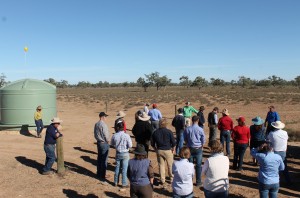
Glenn Humbert talking about his grazing system on “Gurrawarra”
January 12, 2016
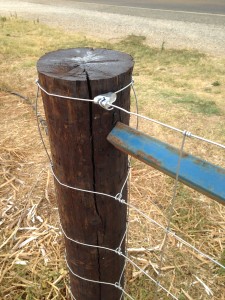
Tied off
When you enter a discussion do you do so with awareness and add energy with bright eyes and encouraging statements? Nothing annoys me more than people entering a discussion, finding reasons why a concept won’t work and then they turn the discussion around to something they would rather talk about, all the while the energy and creativity has left. This normally happens when questions drill down into the detail of concepts (“the devil is in the detail”), you can always find reasons not to do things if you look hard enough. I find energy and enthusiasm such an attractive trait as it isn’t that common, people that will explore ways that things can be done, instead of why not to do it. My network is full of people that have these traits and to balance that off I always have no trouble finding people who will tell me what is wrong with the concept. It is important to have balance, the concepts wouldn’t get legs if not for the energy and enthusiasm provided first up. Last week I gave about 2 ½ days of my time to help a couple of farmers near Freeling (SA) re-fence their paddocks after a really nasty fire went through there at the end of November (Pinery). Now there is no way we would get all of their fencing done in that time so the idea was to kick start it. The 2 neighbours were pretty well organised to start and I had no idea how much we would get up so hard to know how much to organise. We just started on Monday morning with big smiles and lots of energy, well over the course of the time it was amazing how many other volunteers joined and how much fencing we put up. We finished the 1st paddock and the other neighbour had to quickly find us another stretch to put in. Again the enthusiastic network came into play, this wouldn’t have happened without a good mate who organised it and another who travelled from near Keith to give me a hand. When we left on Wednesday we had put up about 2.4km of fencing and the people we were helping were really full of energy to complete the mammoth task ahead. If you work on the motto that “a job started is a job half done” then I would like to think we gave those people a start and left some of our energy and enthusiasm behind that they can spread. Do you leave energy, enthusiasm and goodwill in your wake?
December 13, 2015
When I think of “innovative farmers”, I don’t look for the latest technical/mechanical equipment, instead I look to how they best utilise what they have. Farming to me is more about the connection with the soil, the animals and the plants, than having the shiniest latest and greatest gadget/machine/vehicle. So below is an example of the types of questions I ask around the value of innovations to us:
• How will it improve my connectivity to the soil, plants and animals?
• Can I produce a saleable product while regenerating the landscape?
• Will this add to the plant and animal diversity we have?
• Will this decrease my reliance on fossil fuels, or at least improve my kg of meat, wool/ltr of fuel ratio?
• How will this improve water infiltration and improve biodiversity?
I wish to focus clearly on the outcome, the reason for the innovation, rather than how it helps to get us there. As you can see I don’t look for reducing our labour, I enjoy working on the farm and that keeps me fit, I don’t want to do less of it. There are many fantastic farmers out there that realise how important the Climate change issue is and are constantly innovating and finding better ways to work with the land and turn around land degradation. The benefit of this is that more carbon is stored in the soil feeding the microbes in the soil and this is aided by the soil being covered and having green vegetation year round (regardless of rainfall). The more in tune our farming systems are to the natural environment, the less needs there is for National Parks, this would in turn save the community. This is the direction I see agriculture going due to the multiple benefits to the broader community, not just through healthier ecosystems, the food produced is healthier so the people benefit as well.
A few examples of this can be found here:
Col Seis “Winona” http://www.winona.net.au/pasture-cropping/multi-species-pasture-cropping
David Marsh “Allendale” http://www.arlash.com/2015/09/08/acceleration-is-accelerating/ & http://ecoag.org.au/a-blog-on-holism-from-david-marsh-boorowa/
Bruce Maynard “Willydah” http://www.nokillcropping.com/index.php?option=com_content&view=article&id=52:willydah&catid=37:bruce-maynard&Itemid=56
Angus & Lucy Maurice “Gillinghall” http://www.nokillcropping.com/index.php?option=com_content&view=article&id=47:angus-maurice&catid=38:angus-maurice&Itemid=56
These and many more farmers are putting lots of thought into their farming systems, so that our production systems are not sustainable, they are regenerative, building their production base while storing carbon for all and improving landscape health. This was happening well before the Paris Climate talks #COP21, the hope is that out of the decision made, there will be clear drivers for the increase in this sort of innovation. This is an area that having a diverse mix of people in your decision making team can really help, you need lots of youthful energy and ideas with a long vision for the future, mixed with experience and knowledge of past mistakes and pitfalls to avoid, then of course we need many to fill the important knowledge gaps in between and provide much needed support. How do you judge innovations?
November 20, 2015
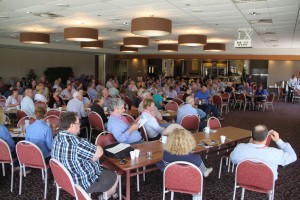
Rangelands Carbon Conference
Cobar 28-29 Oct 2015
We met in Cobar at the Golf Club on Wednesday morning and you could tell it was going to be a great conference by the number of trayback utes and bull bars in the car park, lots of the frontline land managers here, mainly local farmers. The conference drew together 160 people with various interests in the carbon industry, including an estimated 30-40 landholders. The MC of the conference, John Gavin (Remarkable NRM) made sure we ran to time and the conference began with a wonderful welcome to country by local elder Elaine Ohlsen, then we heard from the Cobar shire as well as the Western Local Land services, along with the Australian Government, major supporters of the conference.
The next section of the day focused on describing the carbon market in Australia, the challenges, the regulations and the expectations of the emissions reduction fund. What was also outlined was how you can become part of the market and briefly outlined some methodologies that are approved. What became clear to me was that trading carbon is simply about carbon and all about carbon, with the Australian Government looking to buy at the cheapest price, which in the case of the first auction was about $13.95/t. It was recognised that the outcomes of the Paris climate change talks will have an impact on the carbon market, certainly changing the carbon price.
After smoko the next section discussed “Carbon sequestration in Soils”, as our life depends on the top 6” of soils and I was sitting opposite Louisa Kiely (Carbon Farmers) this section had our attention. Not only did we hear the science behind soil carbon, also the many benefits to Rangeland areas of biodiversity and productivity being two that come to mind. The methodologies that have been approved for soil carbon were also discussed, with the “model based method” being the most popular due to the costs of measurement over such a large scale landscape like we have in western NSW. With the model based method, different management activities have been assigned a carbon value so you combine your proposed management changes and take away your emissions, then you have a package to sell. Some notable points here, was that it was wonderful to hear a local landholder’s perspective (Andrew Mosely) about the benefits of soil carbon. Also that the scientists presenting (Cathy Waters & Susan Orgill) were both working in Agriculture and/or the Rangelands so their material and points they made were really valid.
After lunch we talked about “Carbon sequestration in Vegetation”, this made up about 2/3 of the carbon credits at the 1st auction and most (if not all?) of the projects in the Cobar region fitted in this section. We heard about the different methodologies as well as the trends in woody vegetation (which is fairly obviously increasing), again just so we had a grounded local perspective we heard from a local landholder (Peter Yench) that has an approved project and was successful at the first auction. Peter spoke about how the extra money coming in had allowed him to upgrade the infrastructure on the rest of his land. Russell Grant (Western LLS) spoke about the importance to make sure projects have multiple benefits, not just carbon. We need to address major land degradation issues such as loss of biodiversity, erosion from accelerated overland flows. The point came up about “mosaic agriculture” and the landscape planning around that. Carbon is such a wonderful opportunity to value the landscape and bring about long term benefits to the region as long as extra benefits are included and some planning put into the site of various projects. Unfortunately lots of people aren’t even aware of the wonderful plants and animals that live in Western NSW; this could be an opportunity to help overcome that. We also heard about the Orana Carbon Project, a local project and how carbon trading fits with regional development.
On Thursday morning we begun again at 8.30am sharp, which may have been tough for some after a wonderful dinner on Wednesday night which gave us all a chance to discuss the days talks in more detail and meet some of the presenters in person.
We heard from the beef and cotton industries about the opportunities to participate in the carbon market and the expected returns, while they were too modest in the cotton industry to encourage many, the returns in the beef industry could add up over the scale of businesses in the Rangelands. While planning a project on your property the importance and good spatial information is very important and the NRM Spatial Hub is a project set up to provide that to landholders. I wasn’t aware that they have set their information up in such a way that you can download really good imagery without having wonderful broadband or using up too much of our precious data. Then we heard some of the finer detail around planning carbon projects, like setting your business up for carbon as it is different from primary production and may require a different entity in order to minimise tax. How to register a project and the issuing of Australian Carbon Credit Units (ACCUs) was made clearer by the Clean Energy Regulator.
Sharon Hawke, Assistant Western Lands Commissioner made the point that although the lands involved are leasehold land it has been deemed that the leaseholder owns the right to trade the carbon, this isn’t the case in all states across Australia. Sharon also explained how they were making the pathway to approval as streamlined as possible and she also reiterated the importance of multiple benefits for the future of the region.
The next section talked about climate change, the expected impacts on the region and some of the management options to reduce the negative impacts. Some of the points I got out of this was that although our rainfall average may change there will be (has been) as shift from Winter/Spring rainfall, to more Summer/Autumn rainfall. Combine this with an increase in average temperature and the importance of biodiversity and groundcover was certainly reinforced. Landholders are encouraged to review their lambing/calving time as well as the enterprise mix to make sure it suits the environment and can adapt to change. Again with the local skills available of Greg Curran and Trudie Atkinson, the advice was very pertinent.
Mark Gardner then spoke and this for me brought many issues together, he spoke about landholders “assembling their team”, landholders seek advice from their accountant, bank manager and they work in with their stock agent, how many people consult with their land management specialist? By using good information this opportunity that carbon trading presents, can set your landscape, family, business and community up for not just this generation, for beyond as well. The session finished with a discussion on the impacts to land values of the permanency of the 100 yr time frame most projects have. As these projects are very new, the market is yet to be tested, however with the contract covering parcels of land for either 25 or 100 year time frames, this may impact on the options that a prospective purchaser could have, which may in turn impact on the price they are prepared to pay.
At the wrap up just prior to lunch everyone agreed what a fantastic job the Western Local Land Services (especially Fiona Harris) did in making the conference happen, this was aided by support from the Australian Government as well. This was the first ever Rangelands carbon Conference and we hope that we can have another conference in a couple of years time when we have all experienced more of the carbon market and can talk about the pros and cons then. Fiona was making the presentations available for all to view so that the conference can have wider benefits.
https://www.dropbox.com/sh/iaju5sp4vum6pbb/AADVvwoxMHptJ7qbA2AP3JzPa?dl=0
Also since the conference the Western LLS has released a draft protocol for future carbon projects, so that many benefits can be gained.
What I took away:
• I would have expected that with the outcome of reduced carbon being a healthier environment, then the Australian Government should take this opportunity and make sure projects had long term environmental and social benefits to add to the carbon.
• With the rangeland area of western NSW as a generalisation requiring more healthy grassland and less shrubs, paying landholders to encourage trees/shrubs didn’t make lots of sense to me.
• Carbon to me is a wonderful opportunity to be a driver for positive change as it can place a much needed value on the environment and the services a healthy ecosystem can provide.
• The communities in the rangelands are very fragile, like the landscape so we need to make sure that carbon isn’t just a “gold rush”, providing short term cash injections, rather a driver to positive landscape change bringing back some of the lost productive capacity in the landscape.
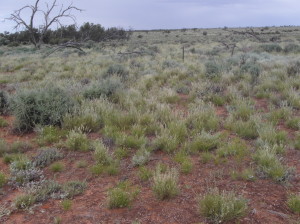
Rangelands
November 16, 2014
As I have said many times before it is wonderful when farmers proudly say they are ethical or provide good animal welfare, organic, naturally grown and many other terms that help describe some of the skills associated with farming. This to me is peer group pressure at work, I do feel inadequate as a farmer and I consider that a great place as I will always strive to succeed and achieve better results for our livestock our land and importantly, us.
I don’t understand why some people feel that if one farmer says they excel in an area such as animal welfare how automatically that means others are bad. Even if they say that others farmers are bad it is usually all relative, as with any issue if you are prepared to accept that you aren’t as good as you can be, that is then an opportunity. I guess one of the main reasons I have trouble understanding this attitude is that I see it as important to continually improve, you never feel comfortable learning new things, that is part of the excitement.
There are so many opportunities to improve in some of the skill areas that we take for granted, for example:
- Improved livestock handling can improve weight gains by as much as 50%.
- Through improved handling of stock you could build a fantastic set of yards for a fraction of the price, no need for all the so called fancy designs.
- Through better livestock handling your fencing costs can also be reduced by at least 50%
- Through providing a more diverse pasture base we can reduce or even stop drenching and/or providing supplements, the flow on effect means those eating the food can reduce their supplements.
- Imagine sowing a winter cereal crop into a summer perennial cover crop reducing chemical, fertilizer and machinery costs,
- You can reduce your overhead costs by redesigning the operation of your business
- By managing your business respecting everyone’s values your productivity increases
As you will notice, none of these options even mention the extra returns you can receive by marketing those qualities, they could be significant. I’m sure that there are many other opportunities out there that are disguised as criticism. By keeping a positive attitude and accepting these opportunities rather than hitting them back at the proponent with a nasty barb, you may be pleasantly surprised the gains you and your farm can make.
July 26, 2014
Most people have good knowledge of the needs and wants of themselves or their families, even their communities, how many of you understand the needs and wants of the land and livestock. With both the land and livestock unable to talk, some may see this as being very difficult, it is certainly open to different interpretations, so this is my interpretation of the need and wants of land and livestock and how we can cater for the needs. To define the difference between needs & wants, I see the wants as just “white noise”, the needs are not negotiable, same as with people.
So the way I see the needs of each group:
Land: The land needs a broad diversity of plant species and ages so that is has resilience to deal with diseases, natural disasters etc. With lots of different plant species the right plants can fulfil their role in the landscape, i.e. plants that can colonise bare areas, naturally ripping the soil so other grasses can follow in succession. E.g. thistles and other plants normally referred to as “weeds”.
The plants also need to be in the right “order”, by that I mean plenty of coarse vegetation (trees & shrubs) on the ridges and predominately grasses down the slopes, this allows for infiltration of water and nutrients that gravity takes down the slope. The land also requires disturbance, the drier the land (brittle) the more dependant it is on disturbance in order for reseeding and natural succession. The plants too require pruning if they are to have longevity in the landscape, the same as in any garden. This is an area we have to try and balance as sometimes the plants are saying “eat me”, when the best thing might be to leave them and wait for the next succession of better plants. By encouraging many different plant species and lots of “untidy” litter on the ground you create a wonderful harbour for many species of insects, birds and animals, all which can help you manage the landscape.
Livestock: The basic needs of animals is access to a “full pantry” of foods and medicines naturally available in a diversity of plants, also good quality water, not too far away. The livestock have many wants, like wanting to be safe and settled in one area through lambing/calving, or even wanting to stay in that one area as their “territory” for their whole life. While delivering on these wants results in higher production it also can impinge on the needs of the land, which as I said are not negotiable.
Identifying the needs can be very easy, managing and balancing those needs with the needs of your family & business can be much more difficult, so again this is how we see it:
Management of these needs: This is the area that can be difficult because it certainly can be hard as we only get paid for our produce (meat or wool) so by looking after the livestock better our income increases, or does it? By placing a nominal value on the needs of the landscape, we use $8/ha/yr (based on our increasing carrying capacity) you can very quickly establish that by fulfilling the wants of the livestock at the cost of the needs of the landscape, any extra income is more than eaten up in reduced land capability.
If society valued the landscape as well as the produce, rather than us having to use nominal figures the answer would be much easier. That is just one of the many complexities farmers have to come to terms with learning the “art of farming”.

Site 2 Looking south
July 4, 2014
Goats are a major component of the total grazing pressure (TGP) in most of southern rangelands of Australia. For that reason they are also a valuable resource that has helped many pastoralists through some very tough low rainfall years, turning the numerous goats into a very lucrative business. The goats are fantastic at looking after themselves in dry periods, they breed like, well goats, the only costs are mustering, handling and freight to abattoirs, they are “pennies from heaven”,….or are they? When it comes to returns from feral goats, they are fantastic for cashflow, long term they will always take out more than you receive.
This feral rangeland goat business comes at a very significant cost to the environment, due to the lack of management of them, by this I mean not treating them as livestock or pests. There are pastoralists our there that manage their goats as livestock and they have really great businesses going due to how well adapted to our harsh landscape that goats are. So when I’m talking about feral rangeland goats I’m clearly talking about unmarked/untagged goats that roam around making their own arrangements as to where they will graze regardless of paddock or boundary fences.
Goats are so well adapted to harsh environments, they can survive and even thrive when other livestock like sheep, cattle and even our wildlife can not. They can do this due to their ability to graze down to a low level and stand on their hind legs to browse, so their food zone is significant. They even enjoy climbing trees, playing on the limbs as well as eating their way along the branches.
Understanding the way animals graze helps us to manage them, now goats love short fresh growth, so you tend to find they stay in areas (sedentary grazing) where they can keep the growth short, this is when they cause landscape degradation. They just go back to the same tasty plants day after day until they die, then moving on to the next tastiest plants. Mind you sheep, cattle, rabbits and even kangaroos can do the same, this is the result of herbivores being very comfortable in their environment While sedentary grazing is best for the livestock, the land suffers through loss of biodiversity, balancing this is where management comes in. Usually the smaller the grazing animal the less plant diversity they encourage, that is one of the main reasons that goats [along with rabbits!] need to be managed.
The productive capacity of the landscape is constantly being reduced by feral goats, this happens insidiously over time so is difficult to cost, therefore acknowledge. Without doubt the biggest threat to the southern rangelands of Australia is unmanaged TGP, also not something that is easily addressed. Some of those options to manage the TGP in the southern rangelands of Australia are: Wild dogs (though not that livestock friendly!). Some landholders are putting in fences to keep goats (as well as other livestock & wildlife) out or in whatever is their choice, either way they have control. Strategic shooting of goats can send a very strong message to them to keep moving and stopping sedentary grazing.
I know that goats are only part of the TGP issue and all components need acknowledgement and respective management. I’m seeing at the moment society’s acceptance of the resource of “feral goats” due to its ability to provide cash to pastoralists, especially in tough times. The whole community needs to take responsibility for the health and wellbeing of a very large part of Australia, we need to value our precious rangelands. With the western division of NSW losing carrying capacity after every significant drought since it was settled, I worry that we will lose many more people, flora & fauna before change happens.














